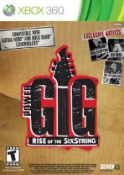Power Gig: Rise of the SixString Review
|
|
See PixlBit's Review Policies

On 11/24/2010 at 04:04 PM by Nick DiMola Why include a real guitar if you aren't going to get to play it like one? |

Go buy a real guitar if you want to truly learn how to play the instrument, because Power Gig isn't going to help you.
As a guitarist, I find Power Gig: Rise of the Six String almost offensive. It had built my hopes up to hear that a true guitar would be included in a modern rhythm game. In my head, I imagined getting the opportunity to truly strum out some tracks, and learn to play some new songs in a manner I've never had the opportunity of doing. But no, rather than using the guitar like an actual guitar, players are stuck doing the same old Green, Red, Yellow, Blue, Orange button-based notes, with an occasional real power chord thrown in. Even worse, by now everyone is used to playing on a standard plastic guitar controller, making this feel like some unnatural compromise between playing that and playing the real thing.

It's a bit confusing why Seven45 Studios took this route with the title. Sure, they beat Harmonix to the punch in including a real guitar in a rhythm game, but they completely neglected to use it in any meaningful way. Aside from use of the guitar, the game is completely derivative of the Rock Band and Guitar Hero series. All of the same options are present, including the ability to sing and play drums, and the various modes all mimic those found in either of the series it draws inspiration from.
With the guitar being the one distinction, it's worth explaining it in depth. First of all, the guitar is noticeably smaller than a standard guitar, particularly the fret board. This makes it a bit easier for anyone to hold the guitar comfortably, particularly the younger crowd. The body is made of plastic and is much lighter than the fret board which must hold all of the electronics. It has a single pick-up which is used for both plugging into a real amp and detecting when the strings are plucked. Specific to this guitar, there is a device which raises up from the body to keep the strings from moving and reverberating.

As I came to realize, it's necessary to keep this strum guard raised at all times while playing, because the game detects strumming by how little the strings reverberate. A short quick vibration is detected by the pick-up, which in turn translates to a single strum. When not engaged, the game will detect the simple vibration of the string as if it were being actively strummed. I say all this because having this guard engaged takes away from the authenticity of playing a real guitar even more so.
Frets two, three, four, five, and six all correspond to green, red, yellow, blue, and orange respectively. Players can choose to play and string along those frets to match the on screen color. When players are given regular chords, such as green and yellow, the same string can be used to play the note, but it's much easier to simply use two different strings. This does set up some distinction from the game's inspirations, but not much.

For whatever reason, the way I seemed to hold down the frets didn't agree with the game, as it often assumed I was holding down a different fret than I actually was. This happened most often for me when holding down the green fret, as the game seemed to pick it up as if I was holding the red one. After some investigation, it appears I hold the string down closer to the bottom of the fret which must've confused the game's detection system. This caused some pretty frequent misses while playing, which really took me out of the whole experience. With a real guitar, it doesn't really matter where you hold down the string on the given fret, the resulting sound is correct no matter what; Power Gig acted as if that wasn't true, which perhaps for starting guitar players that's not a problem, but for anyone versed in the instrument, it has the potential to create some real headaches.
Power chords, which aren't enabled by default, do raise the game's challenge, not because they are particularly difficult to execute, but because they use numbers to display the root string and a color to designate the fret to play from. It's further complicated by open power chords, which specify the string to play the open note on rather than where to actually put your fingers. Perhaps with more play time this wouldn't be so awkward, but as mentioned earlier, it felt like some weird combination of something you'd do with a real guitar and something you'd do in a modern day rhythm game.

The game's tracklist has a few standouts like Breaking Benjamin, Three Days Grace, and Eric Clapton, but the majority of it is unenjoyable. Worse, if players want to make it through the career mode they will have to suffer through many of these tracks multiple times.
After a couple hours with Power Gig, I realized that the game was more enjoyable to play with a standard plastic guitar rather than the pricey real guitar included in the package. Yeah, it's kind of cool that you can use said guitar with a real amp, but for the price, players are better off picking up a starter Squier guitar for the price they'd pay for this poorly done game and the cheap, junky, still mostly plastic guitar included.










Comments